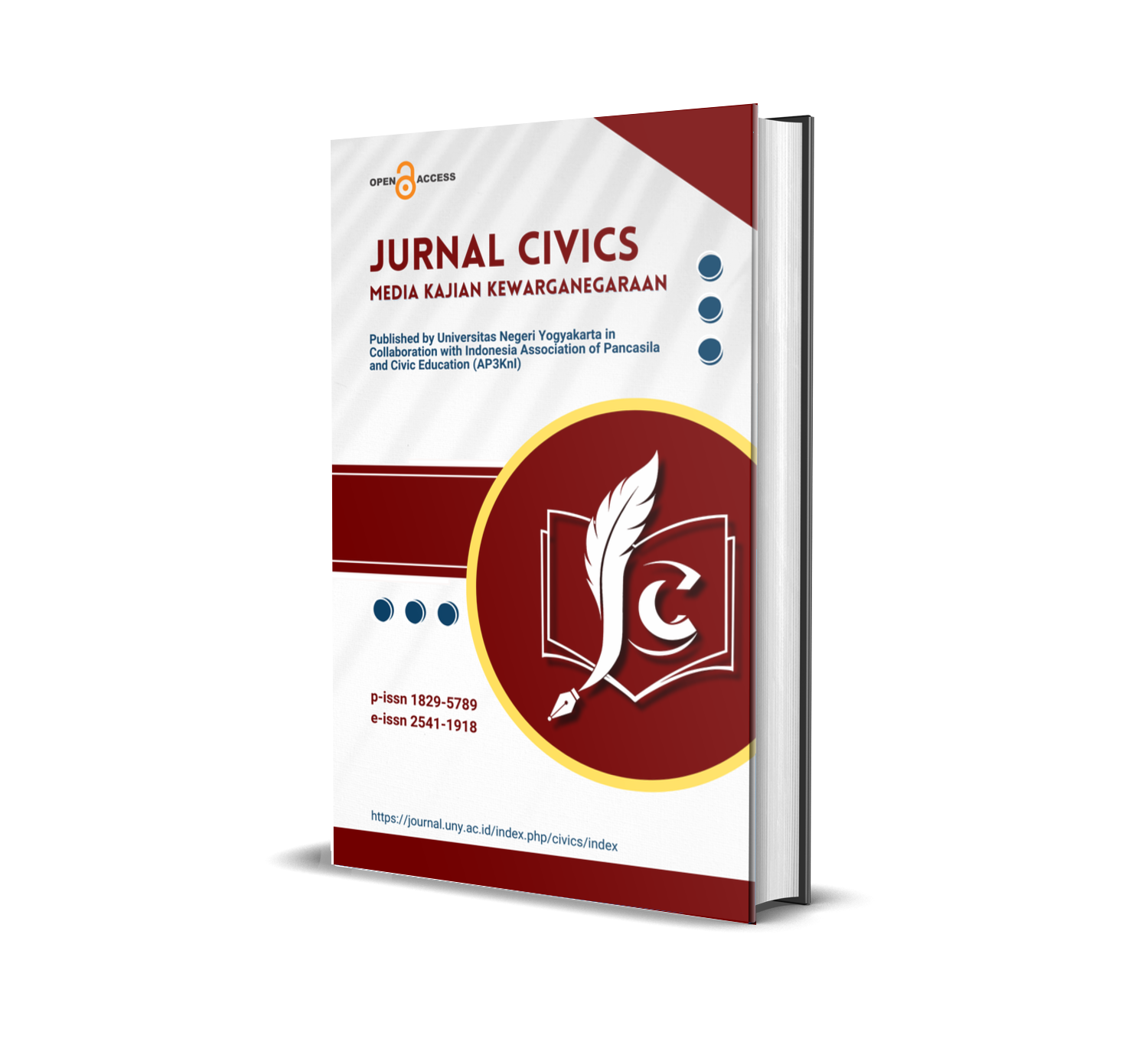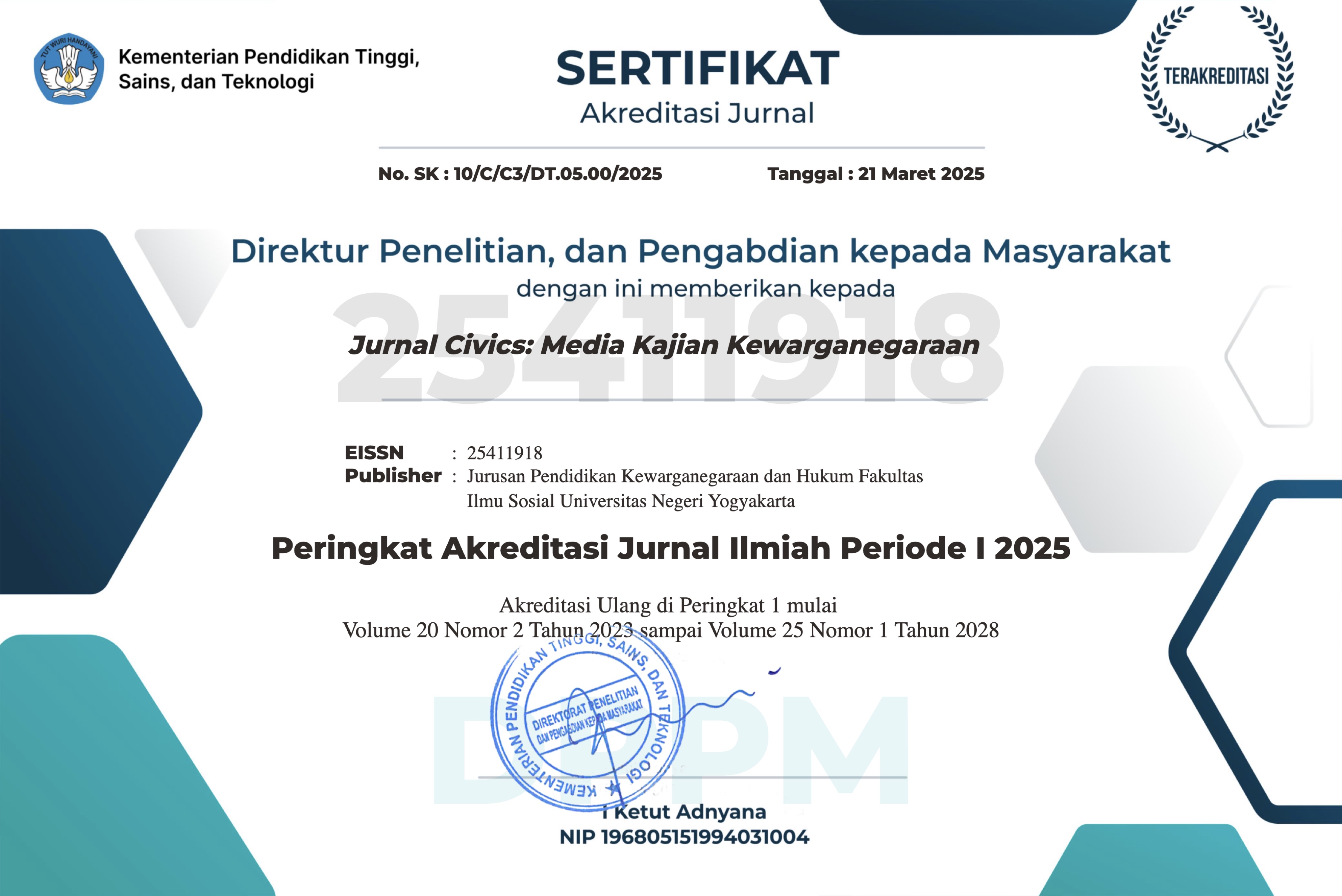Perwujudan nilai-nilai strategis revolusi mental pendidikan pada kearifan lokal pesantren
DOI:
https://doi.org/10.21831/civics.v14i1.14559Keywords:
pesantren, local wisdom, strategic value of mental revolutionAbstract
This research was aimed at describing Pesantren Gunung Jati (SGJ) in internalizing the strategic value of mental revolution in Islamic Senior High School students SGJ through local wisdom as well as revealing the strategies implemented to manage the its supporting points and obstacles. This research was qualitative approach and classified into case study. The result shows the values of "Panca Jiwa Pondok" have been able to shape students' personality with the B3K3N character. Various characteristics used as parameters the success of empowering students' characteristics were: the advisors example, the student's parent trust. The multicultural background of students was an obstacle of the implementation. Strategies implemented to success were became the role model and a happy friend as well as a motivator for students to be patterns of model in building emotional bond.
References
A'la, A. (2006). Pembaruan pesantren. Yogyakarta: Pustaka Pesantren. Abdullah, T. (2001). Nasionalisme dan Sejarah. Bandung: Satya Historika. Anderson, B. (1991). Imagined Community. Reflections on the origin and spread of nationalism. London: Verso. Creswell, J. W. (2015). Qualitatif inquiry & research design: Choosing among five appoaches. (Lazuardi, Trans.). Yogyakarta: Pustaka Pelajar. Hamidi. (2005). Metode penelitian kualitatif; aplikasi praktis pembuatan proposal dan laporan penelitian (I). Malang: UMM Press. Husaeni, A. (2010). Membentuk manusia berkarakter dan beradab. In Seminar Nasional Pendidikan Karakter Membangun Bangsa Beradab. Bandung: Universitas Pendidikan Indonesia. Huszar, & Stevenson. (1961). Political science, An outline. New Jersey: Adams & Co. Patterson. Megawangi, R. (2007). Pendidikan karakter untuk membangun masyarakat madani. IPPK Indonesia Heritage Foundation. Munandar, S. C. U. (1992). Mengembangkan bakat dan kreativitas anak sekolah: Petunjuk bagi para guru dan orang tua. Jakarta: Gramedia. Ritzer, G., & Goodman, D. J. (2005). Teori sosiologi modern. (Alimanda, Trans.). Jakarta: Prenada Media Group. Rofiq, A. (2005). Pemberdayaan pesantren: menuju kemandirian dan profesionalisme santri dengen metode daurah kebudayaan. Yogkayarta: PT LKiS Pelangi Aksara. Rose, C., & Nicholl, M. J. (2006). Accelerated learning for the 21st century (Cara belajar cepat abad 21). (D. Ahima, Trans.). Bandung: Nuansa. Sukmadinata, N. S. (2004). Kurikulum dan pembelajaran kompetensi. Bandung: Yayasan Kesuma Karya. Susilawati, I. (2012). Perbandingan peningkatan kemampuan berpikir kritis siswa didasarkan pada model STAD dan PBL pada mata pelajaran IPS-ekonomi siswa kelas VIII SMP Raden Fatah Batu. Jurnal Karya Ilmiah. Tafsir, A. (2007). Ilmu pendidikan dalam perspektif Islam. Bandung: Remaja Rosdakarya. Yudha, A. S. (2004). Berpikir kreatif pecahkan masalah. On Line]. Tersedia Di Http://www. Kompas. Co. id/.[16 Januari 2010].
Downloads
Published
How to Cite
Issue
Section
Citation Check
License
The authors agree to transfer the transfer copyright of the article to The Jurnal Civics: Media Kajian Kewarganegaraan effective if and when the paper is accepted for publication.
Authors and other parties are bound to the Creative Commons Attribution-NonCommercial-ShareAlike 4.0 International License for the published articles, legal formal aspect of journal publication accessibility refers to Creative Commons Attribution-NonCommercial-ShareAlike 4.0 International License (CC BY-NC-SA).










